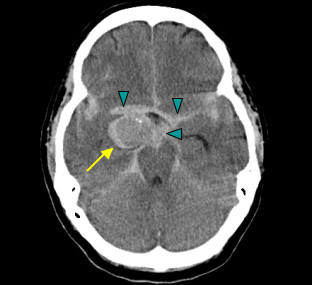
All headaches are not created equal. Earlier we discussed migraines, but there’s a lot more to headaches than those. In fact, when you come to an emergency room with a history of migraines and tell us you’re having a migraine, we still aren’t thinking about migraines as the first consideration. It’s all about the life-threats. The lead picture suggests items to avoid if you’d like to improve your prognosis for headaches in general and especially certain ones like brain aneurysms.
Secondary headaches are those related to some other illness or condition that produces headaches as a symptom. These are much more common causes of headaches than migraines. They’re even more important because they could represent life-threatening conditions. So we’ll put aside the headaches caused by things like panic attacks and hyperventilation, influenza, dental pain, sinusitis, ear infections, eye strain, dehydration, hangovers, hunger and ‘brain-freeze’ (Yes, ‘ice-cream headaches’ really are a thing!), and point you to some conditions about which you should be concerned (I’m intentionally leaving out many especially uncommon and otherwise esoteric conditions. I wouldn’t want to encourage any hypochondriacs out there.).
- AVM (arteriovenous malformation): an abnormal formation of blood vessels inside your brain
- Concussions and post-concussive syndrome
- Brain aneurysm: a ballooning of one of your brain’s arteries
- Brain tumor
- Carbon monoxide poisoning
- Encephalitis/Meningitis: inflammation and/or infection of different components of your brain
- Subarachnoid hemorrhage: and other intracranial hemorrhages
- Stroke
- Temporal arteritis: inflammation of an important forehead artery with potentially devastating consequences to your sight.
Given that I’ve blogged on several of these already (you can always enter the term in the search box on the right for more details), I’m going to focus on the symptoms you may have that may suggest your headache is different enough to get evaluated for a possible life-threat.
Consider this a ‘headache plus this symptom = go to the emergency room’ list
- Altered mental status
- Confusion
- Difficulty standing or walking (different from baseline)
- Fainting after a headache
- High fever, greater than 102 F to 104 F (39 C to 40 C)
- Nausea or vomiting that’s not hangover related
- Numbness, weakness or paralysis on one side of your body
- Slurred speech
- Stiff neck
- Vision disturbances (blurred or inability to see)



So, even if I’ve previously been under the observation of a physician and have been diagnosed with migraines by process of elimination but regularly have headaches with substantially blurred vision, should I be concerned?
Hi, Dee. Great question. If you’ve been evaluated, most likely you’re having an exacerbation of that same process. However, it’s the role of the emergency physician to be skeptical. In this case, you should attempt to contact your primary physician first, who’ll direct you accordingly. Even with an existing history, you should be concerned by an increase in frequency or severity of symptoms or for the addition of one of the trouble symptoms I referenced. Thanks for following.